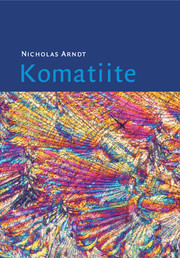Book contents
- Frontmatter
- Contents
- Preface
- Part I Background information – description of the field characteristics, mineralogy and geochemistry of komatiites
- 1 A brief history of komatiite studies and a discussion of komatiite nomenclature
- 2 Brief descriptions of six classic komatiite occurrences
- 3 Field characteristics, textures and structures
- 4 Mineralogy
- 5 Geochemistry
- 6 Isotopic compositions of komatiites
- 7 Experimental petrology
- Part II Interpretation – the manner of emplacement, the origin and the tectonic setting of komatiites
- References
- General index
- Localities
- Plate section
5 - Geochemistry
from Part I - Background information – description of the field characteristics, mineralogy and geochemistry of komatiites
Published online by Cambridge University Press: 27 August 2009
- Frontmatter
- Contents
- Preface
- Part I Background information – description of the field characteristics, mineralogy and geochemistry of komatiites
- 1 A brief history of komatiite studies and a discussion of komatiite nomenclature
- 2 Brief descriptions of six classic komatiite occurrences
- 3 Field characteristics, textures and structures
- 4 Mineralogy
- 5 Geochemistry
- 6 Isotopic compositions of komatiites
- 7 Experimental petrology
- Part II Interpretation – the manner of emplacement, the origin and the tectonic setting of komatiites
- References
- General index
- Localities
- Plate section
Summary
Introduction
Komatiites are extinct. The last eruption we know of took place on Gorgona Island some 90 Ma ago, and although sightings are regularly claimed in the literature and even more frequently in manuscripts submitted for review, none of these is convincing. When dealing with the chemical compositions of modern basalts, andesites, phonolites, even carbonatites, a natural step is to obtain samples of newly erupted lavas that are essentially unaltered and have compositions like those of the original magmas. We know of no newly erupted komatiites, and even the youngest examples – the Cretaceous Gorgona komatiites – have been affected by the circulation of hydrothermal fluids. They contain secondary hydrous minerals in veins and as pseudomorphic replacement of olivine and glass, and chemical analyses typically contain a small percentage of H2O, and variable ferrous/ferric iron ratios. Such features would be grounds for rejection from many data banks of modern igneous rocks.
The freshest Archean komatiites, those from the Zvishavane area in Zimbabwe, are only slightly more altered than the Gorgona rocks, but most other known examples of Precambrian komatiites are less well preserved. It must be accepted that all komatiites are altered to a greater or lesser extent, and any investigation of their geochemistry has to deal with this alteration.
A special characteristic of komatiites allows us to do this, and indeed by using this characteristic, the chemistry of komatiites can often be interpreted more confidently than that of all other Precambrian or even early Phanerozoic volcanic rocks.
- Type
- Chapter
- Information
- Komatiite , pp. 130 - 166Publisher: Cambridge University PressPrint publication year: 2008

